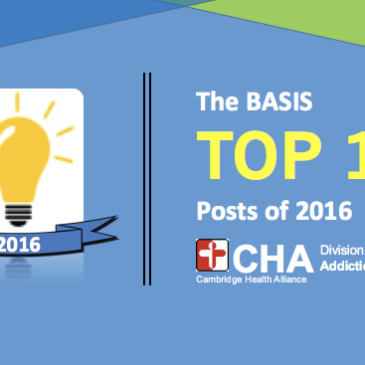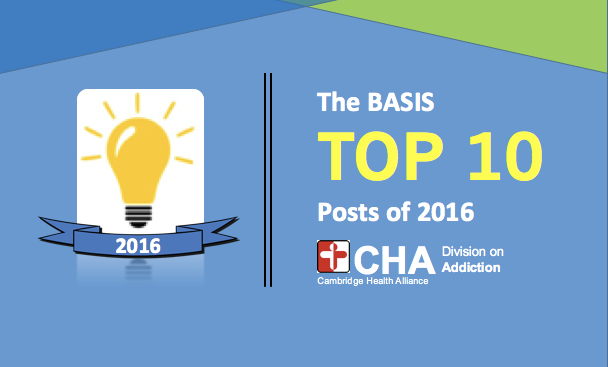Today, we reflect on our efforts to share addiction science during the past year. We hope that you’ve benefited from the material we’ve posted this year, from our weekly reviews of scientific studies of smoking, gambling, drinking, and other kinds of substance use to our editorials from researchers, treatment providers, and those who have personally experienced addiction.
We’d love to learn more about how you’ve used The BASIS in your own life! Please share your experiences by emailing us at basis@divisiononaddictions.org.
Here are our top 10 most viewed articles from this past year:
1. Moderation, Hope and Compassion: A Physician’s Prescription for Responding to the Opioid Epidemic
Our most read article of 2016 was Dr. Mark Albanese’s op-ed published as part of our Special Series on Opioid Dependence and Recovery. Dr. Albanese invites us to approach the opioid epidemic with hope and compassion. Here at The BASIS, we are always honored to have dedicated clinicians like Dr. Albanese share their work and opinions about addiction. This op-ed shares vital insight on how to reduce stigma and practice patience and compassion.
2. Challenging addiction treatment: The intersection of policy, practice & science
At #2 on our list, Anjali Talcherkar’s op-ed suggests the need for complementary and alternative solutions to addiction. Ms. Talcherkar is a researcher, clinician, and person in recovery. She wrote this op-ed while completing the Division on Addiction’s Summer Research Mentorship program.
3. The tipping point in addiction
Dr. Lance Dodes, former Assistant Clinical Professor of Psychiatry at Harvard Medical School, discusses what he believes are misconceptions and myths that surround addiction, with a focus on 12-step programs and the neurobiological model of addiction.
This post reviewed a study that explored the connections among alcohol dependence, drinking expectations, and a condition called alexthymia. Alexthymia is marked by difficulty recognizing, processing, and communicating one’s own, and others’, emotions. This study is an example of how health conditions can predispose people for unhealthy substance use.
Life after addiction is just as important as the first steps to change. This research review explores the differences between abstinent and non-abstinent people in recovery. This article reminds us that it is important to research different treatment strategies and their outcomes to best serve those in recovery.
6. STASH, Vol. 12(6) – When it comes to methadone maintenance treatment, one size does not fit all
Methadone maintenance programs certainly has their benefits when treating addiction, but do certain factors lead to early discharge? This research review examines a study that suggests that there are certain personal characteristics that increase the risk of premature discharge, which can lead to more negative outcomes.
The BASIS often features studies that increase awareness about a certain cause or topic in addiction. This review was written to raise awareness about addiction and domestic violence. It describes a study exploring the role of domestic violence experiences and future substance abuse among adolescents.
8. The WAGER, Vol. 21(2) – Problem gambling has more to do with how you gamble than where you do it
This post reviewed a study that compared problem gambling behavior among three groups of gamblers: (1) those who only gamble in gambling facilities, (2) those who only gamble online, and (3) those who gamble both ways. This study offers interesting insight on the behavior of gambling patrons and development of problem gambling.
9. The WAGER, Vol. 21(5) – Alcohol and suicidal ideation among gamblers
Here, The WAGER reviewed a study of the relationships among gambling, alcohol use and suicidal ideation. It appears that having a gambling problem strengthens the relationship between drinking and suicidal ideation. It is important to study the conjunction of risky behaviors—such as heavy drinking and heavy gambling— and their risk to the individual.
10. STASH, Vol. 12(3) – Stimulant use and gambling among college students
Last on our 2016 Top 10 list is a review that examined the relationship between stimulant use and gambling among college students. College students in particular are at risk for numerous harmful behaviors. Educating young adults about the risks associated with these behaviors is especially important, and is why education remains one of our primary objectives.
Thank you for reading The BASIS during 2016! Use the Comment section to tell us which post was your favorite.
Best wishes for a happy holiday season.
Sincerely,
Alec Conte, BASIS Writer
Did you know that the Division on Addiction is entirely self-funded? That means that we rely on grants, contracts, and gifts to produce all of our work, including The BASIS. Please help us continue our work by making your year-end, tax-deductible donation to The BASIS today. Together we can continue to advance the public’s understanding of addiction and, ultimately, improve the lives of people touched by addiction. Any amount makes a difference. Please support us now with a donation.





